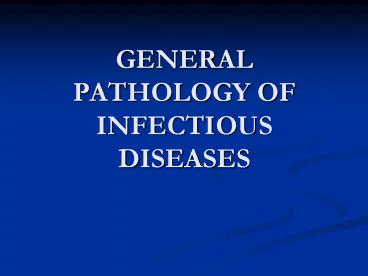GENERAL PATHOLOGY OF INFECTIOUS DISEASES PowerPoint PPT Presentation
1 / 29
Title: GENERAL PATHOLOGY OF INFECTIOUS DISEASES
1
GENERAL PATHOLOGY OFINFECTIOUS DISEASES
2
Infectious Diseases
- Are disorders in which tissue damage or
dysfunction is produced by a micro-organism - Classified as
- Contagious (person to person)
- Non-contagious acquired from
- -Exogenous sources such as animals, insects,
soil, air - -or originating from endogenous microbial flora
of the body
3
Factors That Influence TheDevelopment Of Disease
4
1-Host factors in infection
- Inherited differences in response to infecting
agents - Effects of age on response to infection
- Effects of behavior on infection
- Effects of the condition of the host defenses on
infection
5
2-Virulence
- Is the capacity of an organism to achieve
infection - The organism must
- 1-Gain access (enter) to the body
- 2-Avoid the host defenses
- 3-Accommodate to growth (be able to grow) in the
human environment - 4-Parasitize (live on) human resources
6
Host Defense Mechanisms
- Skin
- Tears
- Normal bacterial flora
- Gastric acid
- Bile
- Salivary and pancreatic secretions
- Mucociliary blanket
- Secretions e.g. bronchial secretion
- Immune system (e.g. neutrophils, monocytes)
7
Host Factors In Infection
- An infectious agent may
- Fail to infect some persons
- Produce asymptomatic infections
- Cause symptomatic disease
- Produce lethal (deadly) infection
8
Effect of age on response to infection
- -The age of the host affects the outcome of
exposure to many infectious agents - 1-Some organisms produce more severe disease in
utero than in children or adults (e.g. German
Measles)
9
- 2-Tuberculosis in children lt 3 y ? more severe
due to immaturity of the immune system) - 3-The elderly ? (common respiratory illnesses are
more often fatal in persons over 65 y)
10
How Infectious Agents Can CauseDisease
- 1-They can contact or enter host cells and
directly cause cell death - 2-They can release
- a)Endotoxins or exotoxins that kill cells
- b)Enzymes that degrade tissue components
- 3)They can induce host cell responses that cause
tissue damage usually by immune-mediated
mechanisms
11
BACTERIAL INFECTION
12
Bacteria Induced Injury Depends On
- Damage to host cells depends on the ability of
bacteria to adhere to and enter host cells or to
deliver toxins
13
Mechanism Of Bacterial Injury
- Production of toxins
- a) Endotoxins
- b) Exotoxins
- Hypersensitivity reaction causing tissue injury
i.e. the immune response to infection - Tissue invasion by microbes
14
Bacterial Endotoxins
- A lipopolysaccharide (LPS) - a structural
component of the outer cell wall of gram negative
bacteria - Biologic effects of endo-toxins
- Induction of fever
- Septic shock
- Disseminated intravascular coagulation (DIC)
- Acute respiratory distress syndrome (ARDS)
- Effects on the cells of the immune system
15
Bacterial Exotoxins
- Are secreted proteins that directly cause cell
injury and disease manifestations - Examples of bacteria that secrete exotoxins
- Diphtheria bacteria
- Bacillus anthraces
16
INFLAMMATORY RESPONSE TOINFECTIOUS AGENTS
17
Effects of bacterial infection
- Cell injury ? necrosis and degeneration
- Inflammation acute or chronic
- Blood invasion by bacteria or its products
leading to either - Bacteraemia
- Toxaemia
- Septicaemia
- Pyaemia
18
Bacteraemia
- Transient invasion of the blood with bacteria
without significant toxaemia - Examples
- After tooth extraction
- Blood spread from a septic focus as tonsillitis
19
Toxaemia
- This is the circulation of bacterial toxins
leading to harmful effects - Types
- Acute toxemia e.g. typhoid fever diphtheria
- Chronic toxemia e.g. lung abscess T.B. disease
20
Septicaemia
- A serious fatal condition in which large numbers
of virulent bacteria circulate and multiply in
the blood accompanied by severe toxemia
21
Pyaemia
- Development of small abscesses (pyaemic abscess)
within one or more organ causes by circulating
septic emboli. The condition is commonly fatal
22
Opportunistic Infections
23
Opportunistic Infections (OI)
- Infections with pathogenic micro-organisms which
occur in persons with advanced immunodeficiency
24
Opportunistic Infection classifications
- Fungal infections
- Bacterial infections
- Viral infections
- Protozoal infections
25
Fungal Opportunistic Infections
- Candidiasis
- Pneumocystis carinii pneumonia (PcP)
- Aspergillosis
- Cryptococcosis
26
Bacterial Opportunistic Infections
- Recurrent bacterial pneumonia
- Progressive Tuberculosis
27
Viral Opportunistic Infections
- Herpes viruses
- Cytomegalovirus (CMV)
28
Protozoal Opportunistic Infections
- Toxoplasmosis
- Giardiasis
29
THANK YOU

